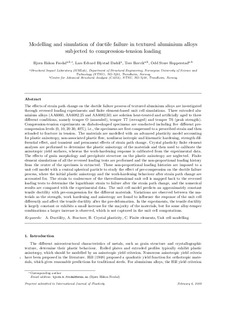| dc.contributor.author | Frodal, Bjørn Håkon | |
| dc.contributor.author | Dæhli, Lars Edvard | |
| dc.contributor.author | Børvik, Tore | |
| dc.contributor.author | Hopperstad, Odd Sture | |
| dc.date.accessioned | 2019-03-13T10:23:29Z | |
| dc.date.available | 2019-03-13T10:23:29Z | |
| dc.date.created | 2019-02-07T10:45:03Z | |
| dc.date.issued | 2019 | |
| dc.identifier.issn | 0749-6419 | |
| dc.identifier.uri | http://hdl.handle.net/11250/2589828 | |
| dc.description.abstract | The effects of strain path change on the ductile failure process of textured aluminium alloys are investigated through reversed loading experiments and finite element-based unit cell simulations. Three extruded aluminium alloys (AA6060, AA6082.25 and AA6082.50) are solution heat-treated and artificially aged to three different conditions, namely temper O (annealed), temper T7 (overaged) and temper T6 (peak strength). Compression-tension experiments on diabolo-shaped specimens are conducted including five different pre-compression levels (0, 10, 20 30, 40%), i.e., the specimens are first compressed to a prescribed strain and then reloaded to fracture in tension. The materials are modelled with an advanced plasticity model accounting for plastic anisotropy, non-associated plastic flow, nonlinear isotropic and kinematic hardening, strength differential effect, and transient and permanent effects of strain path change. Crystal plasticity finite element analyses are performed to determine the plastic anisotropy of the materials and then used to calibrate the anisotropic yield surfaces, whereas the work-hardening response is calibrated from the experimental data. The effects of grain morphology and precipitate structure on the plastic anisotropy are neglected. Finite element simulations of all the reversed loading tests are performed and the non-proportional loading history from the centre of the specimen is extracted. These non-proportional loading histories are imposed to a unit cell model with a central spherical particle to study the effect of pre-compression on the ductile failure process, where the initial plastic anisotropy and the work-hardening behaviour after strain path change are accounted for. The strain to coalescence of the three-dimensional unit cell is mapped back to the reversed loading tests to determine the logarithmic strain to failure after the strain path change, and the numerical results are compared with the experimental data. The unit cell model predicts an approximately constant tensile ductility with pre-compression for the different materials. Variations are observed between the materials as the strength, work hardening and anisotropy are found to influence the response of the unit cell differently and affect the tensile ductility after the pre-deformation. In the experiments, the tensile ductility is largely constant or exhibits a small increase for the majority of the materials, but for some alloy-temper combinations a larger increase is observed, which is not captured in the unit cell computations. | nb_NO |
| dc.language.iso | eng | nb_NO |
| dc.publisher | Elsevier | nb_NO |
| dc.rights | Attribution-NonCommercial-NoDerivatives 4.0 Internasjonal | * |
| dc.rights.uri | http://creativecommons.org/licenses/by-nc-nd/4.0/deed.no | * |
| dc.title | Modelling and simulation of ductile failure in textured aluminium alloys subjected to compression-tension loading | nb_NO |
| dc.type | Journal article | nb_NO |
| dc.type | Peer reviewed | nb_NO |
| dc.description.version | acceptedVersion | nb_NO |
| dc.source.journal | International journal of plasticity | nb_NO |
| dc.identifier.doi | https://doi.org/10.1016/j.ijplas.2019.01.008 | |
| dc.identifier.cristin | 1674397 | |
| dc.relation.project | Norges forskningsråd: 237885 | nb_NO |
| dc.description.localcode | © 2019. This is the authors’ accepted and refereed manuscript to the article. Locked until 31.01.2021.due to copyright restrictions. This manuscript version is made available under the CC-BY-NC-ND 4.0 license http://creativecommons.org/licenses/by-nc-nd/4.0/ | nb_NO |
| cristin.unitcode | 194,64,45,0 | |
| cristin.unitname | Institutt for konstruksjonsteknikk | |
| cristin.ispublished | false | |
| cristin.fulltext | postprint | |
| cristin.qualitycode | 2 | |

